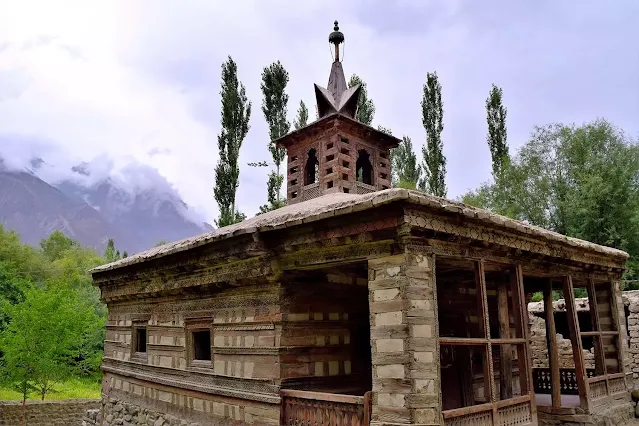Chaqchan Mosque: Oldest Mosque of Gilgit-Baltistan and Pakistan

Chaqchan Mosque is one of the most significant landmarks in Gilgit-Baltistan, Pakistan. It is located in the Yaseen Valley, a remote valley in Ghizer district, which is about 260 km away from Gilgit city. The mosque is considered the oldest in the region, with some experts believing that it is the oldest in Pakistan. The mosque is believed to have been built in the 8th century AD during the Umayyad Caliphate period.
The Chaqchan Mosque was rediscovered in the early 20th century by Sir Aurel Stein, a Hungarian-British archaeologist, who visited the mosque during his exploratory journey through the region. Stein noted the mosque's distinctive architecture, which is a unique blend of Central Asian and Indian styles. The mosque's location in the valley's remote, mountainous terrain adds to its allure.
The mosque's architecture is striking, featuring intricate brickwork, wooden panels, and inscriptions in Kufic script, which is a form of Arabic calligraphy. The mosque's interior is divided into two chambers, with the larger one being the prayer hall and the smaller one serving as the imam's chamber. The prayer hall is particularly notable, with a high-domed ceiling and a mihrab (a niche in the wall) facing the direction of Mecca.
One of the mosque's most significant features is its minaret, which is about 30 feet high and is topped with a conical roof. The minaret is built of brick and has three levels, with the topmost level featuring intricate geometric patterns and Kufic inscriptions. The minaret's design is particularly noteworthy, featuring a unique combination of Indian, Central Asian, and Persian architectural styles.
The mosque's remote location and historical significance have made it a popular destination for tourists and history enthusiasts alike. The mosque has also played an important role in the region's cultural and religious life, serving as a place of worship and a symbol of the area's rich history.
Despite the mosque's importance, it has faced significant challenges in recent years. The mosque's remote location has made it vulnerable to natural disasters, including earthquakes and landslides, which have damaged the structure. Additionally, the mosque's historical significance has made it a target for looters and vandals. To address these challenges, efforts are underway to protect and preserve the mosque, including restoration projects and increased security measures.
Chaqchan Mosque is a unique and significant landmark in Gilgit-Baltistan, Pakistan. Its remote location, distinctive architecture, and historical significance make it a must-visit destination for tourists and history enthusiasts alike. While the mosque has faced significant challenges in recent years, efforts are underway to protect and preserve this important cultural and religious site for generations to come.
Frequently Asked Questions about Chaqchan Mosque (FAQs):
What is the Chaqchan Mosque?
The Chaqchan Mosque is the oldest surviving mosque in Gilgit-Baltistan and Pakistan.
Where is the Chaqchan Mosque located?
The Chaqchan Mosque is located in the town of Khaplu, in the Ghanche district of Gilgit-Baltistan, Pakistan.
Who built the Chaqchan Mosque?
The mosque was built by Mir Sayyid Ali Hamadani, a prominent Islamic scholar and Sufi saint, in the 14th century.
What is the architectural style of the Chaqchan Mosque?
The mosque is built in a traditional Islamic architectural style, with a wooden roof, mud-plastered walls, and intricate wood carvings.
What is the significance of the Chaqchan Mosque?
The mosque is considered an important cultural and historical landmark, reflecting the rich Islamic heritage of the region.
Is the Chaqchan Mosque still in use?
Yes, the mosque is still in use today and serves as a place of worship for local residents.
Can visitors enter the Chaqchan Mosque?
Yes, visitors are allowed to enter the mosque, although they are expected to dress modestly and remove their shoes before entering.
What other attractions are there in Khaplu?
Khaplu is known for its scenic beauty and rich cultural heritage, with other notable attractions including the Khaplu Fort, the Chaqchan Mosque, and the traditional bazaars.
Is Khaplu safe for tourists?
Yes, Khaplu is generally considered a safe place for tourists to visit, although it is always recommended to take necessary precautions while traveling in any unfamiliar area.
How do I get to Khaplu?
Khaplu can be reached by road from Skardu, which is served by flights from Islamabad. It can also be accessed from Gilgit via the Shigar Valley.




